The 15 Species Of Critically Endangered New World Monkeys
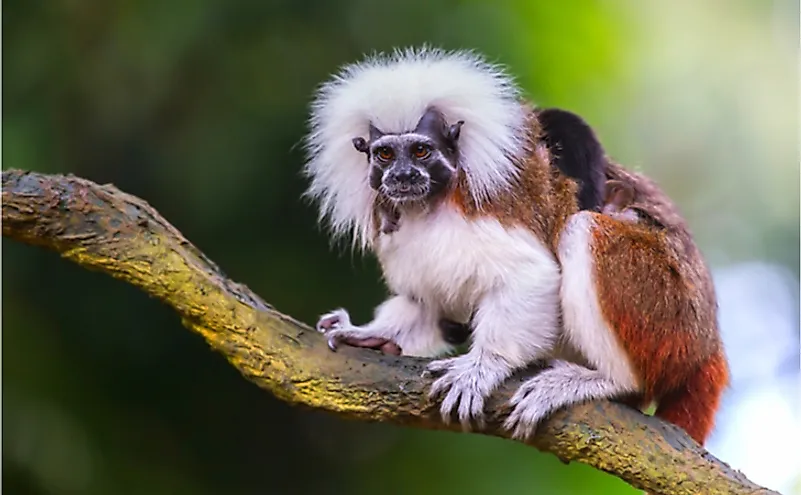
New World monkeys are a diverse group of medium and small arboreal primates found in the tropical regions of Mexico, Central, and South America. New World monkeys are thought to have diverged from Old World monkeys and apes about 40 million years ago. Their ancestors are believed to have migrated to the Americas via Island hopping or on rafts of vegetation. The extant species of New World monkeys are classified into five families, 20 genera and 156 species. The monkeys exhibit fascinating diversity in their distribution, behavior, diet, and morphology. Unlike several Old World monkeys, all New World monkeys are arboreal. They are all also diurnal, except for owl monkeys.
Black-headed Spider Monkey
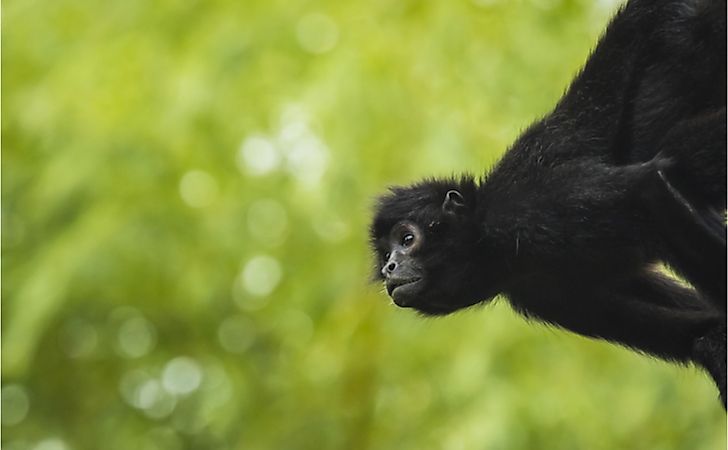
The black-headed spider monkey is scientifically known as Ateles fusciceps. They are found in Central and South America. The species are spread across countries such as Panama, Colombia, and Ecuador. The species lives in subtropical and tropical humid forests with altitudes of 330 and 5,580 feet. Black-headed spider monkeys feed on leaves and ripe fruits. Occasionally, they also supplement their diet with seeds, nuts, eggs, and insects. Currently, they are classified as critically endangered on the IUCN red list.
Brown Spider Monkey
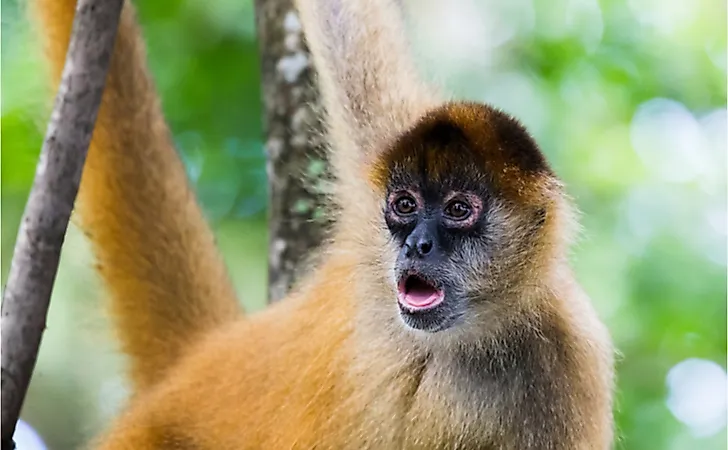
The brown spider monkey, which is also known as the variegated spider monkey, is found in forests in northwestern Venezuela and northern Columbia. Its scientific name is Ateles hybridus. They prefer living in the canopies of tall trees in rainforest habitats. They can also be found in the canopies of semi-deciduous forests. The brown spider monkey is a diurnal forager that prefers ripe fruit. During the dry season, the species also feeds on seeds, leaves, flowers, honey, decaying wood, and insects. Brown spider monkeys are also known to descend trees to eat soil and clay. Scientists suspect that the soil and clay provide essential minerals that might be lacking in their diet. Brown spider monkeys are considered critically endangered by the IUCN. The main threat to the brown spider monkey is habitat loss as a result of deforestation.
Northern Muriqui
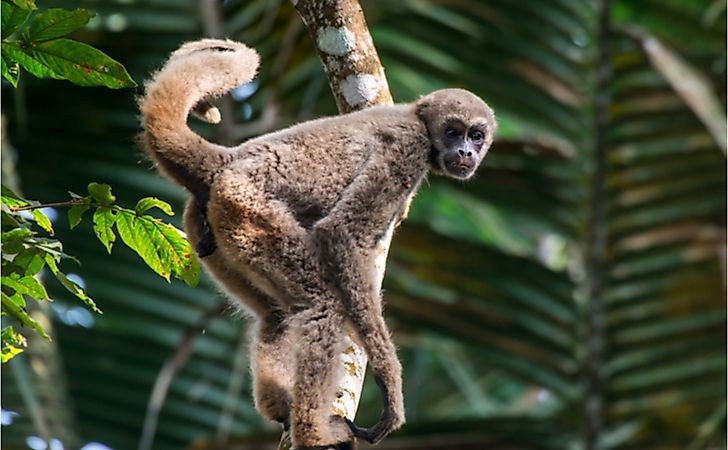
The Northern muriqui is scientifically known as Brachyteles hypoxanthus. The species is native to Brazil. The northern muriqui can be found in the Atlantic forest region situated in the Brazilian states of Espirito Santo, Minas Gerais, Bahia, and Rio de Janeiro. They reside in tropical, semi-deciduous, and late-successional forests (forests that have remained unchanged in composition for a long time). Such areas have trees with an average height of 44 feet, which provide dense canopies that allow them to travel quickly from one treetop to another. The species can also be found in sections of primary forest, secondary forest, scrub forest, and highly disturbed parts of secondary vegetation. Their range excludes lowland forests in northern Espirito Santo and South of Bahia. Their diet consists of leaves, fruits, flowers, buds, seeds, and tree bark. One of their favorite plant species belongs to the genus Anadenanthera. The seeds of the tree which have been nicknamed “magic beans” cause hallucination and have psychoactive effects. The Northern muriqui is considered critically endangered by the IUCN.
Barbara Brown’s Titi
Barbara Brown’s titi is also known as the northern Bahian blond titi or blond titi monkey. The species is scientifically known as Callicebus barbarabrownae. Barbara Brown’s titi monkeys are endemic to the Atlantic forest region in eastern Brazil. They live in habitats situated in caatinga and dry scrubland with a preference for dense arboreal caatinga. They are mainly arboreal forest dwellers and are rarely seen to descend from trees. Barbara Brown’s titi feeds on fruits, leaves, small vertebrates, insects, and bird eggs. Barbara Brown’s titi is considered critically endangered by the IUCN. There are currently about 260 individuals in the world, and scientists believe that the population is likely to decline further going into the future.
Caqueta Titi
The Caqueta titi is scientifically known as Plecturocebuscaquetensis. The species is also known as the bushy-bearded titi or red-bearded titi. It is native to Columbia. The Caqueta titi is found deep in the hot and humid rainforests of Colombia’s Caqueta region, which is close to the border of Peru and Ecuador. Their range encompasses a region estimated to be about 39 square miles. The area consists of bushes and dense, and low forests made up of small, broadleaved trees with an average height of 33 to 49 feet. Caqueta titi monkeys feed mainly on fruits. They also supplement their diet with flowers, seeds, leaves, and occasionally with insects and worms. The species is considered critically endangered by the IUCN. There are currently fewer than 250 adult Caqueta titi monkeys.
Rio Mayo Titi
The Rio Mayo titi is a species of titi that is endemic to Peru and parts of Brazil. The species is scientifically known as Plecturocebus oenanthe. They reside in dry woodland regions with a lot of plants. The species can be found in the Upper Paraguay Basin, Brazil’s Atlantic coast, tropical sections of the Amazon, Santa Cruz, and in the foothills of the Andes. Their diet consists of leaves, fruits, seeds, and arthropods. Rio Mayo titi monkeys are classified as critically endangered by the IUCN.
Ecuadorian Capuchin
The Ecuadorian capuchin is also known as the Ecuadorian white-fronted capuchin and scientifically as Cebus aequatorialis. They are found in tropical forests in Peru and Ecuador. They feed mainly on fruits and other plant parts. The Ecuadorian capuchin is considered critically endangered by the IUCN.
Kaapori Capuchin
The Kaapori capuchin is scientifically known as Cebus kaapori. The species is found in Para and Maranhao states of Brazil situated along the Atlantic coast. Kaapori capuchin monkeys prefer dense forest regions that have an abundant food supply. They can also be found in areas with secondary growth during the dry season. The species is omnivorous with their diet consisting of ripe fruits, plants, insects, snails, and eggs. The Kaapori capuchin is classified as critically endangered on the IUCN red list.
Black Bearded Saki
The black-bearded saki is scientifically known as Chiropotes satanas. They are native to Brazil, Venezuela, Guyana, and Suriname. In Brazil, the species can be spotted in the terra firma forests and at times in regenerating forests. In Suriname, the black-bearded saki is found in mountain savannah forests in the upper and middle levels. The species feeds on about 85 plant species. Immature seeds and ripe fruit make up the bulk of their diet. The black-bearded saki is currently listed as critically endangered by the IUCN.
Colombian Woolly Monkey
The Colombian woolly monkey is scientifically known as Lagothrix lugens. The species is considered critically endangered by the IUCN and is primarily found in Colombia and possibly in Venezuela. They prefer living in the tropical forest of the northwestern part of South America. Their diet consists of leaves, seeds, flowers, nuts, insects, and nectar.
Superagui Lion Tamarin
The Superagui lion tamarin or black-faced lion tamarin is scientifically known as Leontopithecus caissara. The species is found in the coastal forests of southeastern Brazil, where there are currently fewer than 400 individuals. They prefer living in swampy and inundated secondary forest, arboreal Restinga, and lowland forests. The species feeds on small fruits, young leaves, invertebrates, nectar, and mushrooms. The Superagui lion tamarin is currently listed as critically endangered on the IUCN Red List.
Yellow-tailed Woolly Monkey
The yellow-tailed woolly monkey is scientifically known as Oreonax flavicauda. The species is found in the Peruvian Andes in the San Martin and Amazonas departments. Their habitat consists of rough terrain, steep mountainsides, deep river gorges, and canopies at the height of 65 to 82 feet. They prefer living in montane cloud forests of the Peruvian Andes at altitudes of 4,900 to 8,900 feet. Their diet consists of fruits, seeds, nuts, shoots, flowers, leaves, and insects. The species is classified as critically endangered by the IUCN
Cotton-top Tamarin
The cotton-top tamarin is scientifically known as Saguinus oedipus. They are found in Brazil and the northwestern part of Colombia. Currently, they exist in fragmented parks and reserves, such as the Paramillo National Park. They can be found in humid tropical forests to the south and tropical dry forests in the north as well as both secondary and primary forests. Their diet consists mainly of fruits, seeds, and insects. They are currently listed as critically endangered.
Blond Capuchin
The blond capuchin is endemic to the northeastern part of Brazil. The species is scientifically known as Sapajus flavius. They are found in Atlantic forests in the Brazilian states of Alagoas, Pernambuco, and Paraiba. They feed on leaves, fruits, seeds, flowers, frogs, and arthropods. The species is classified as endangered.
Golden-bellied Capuchin
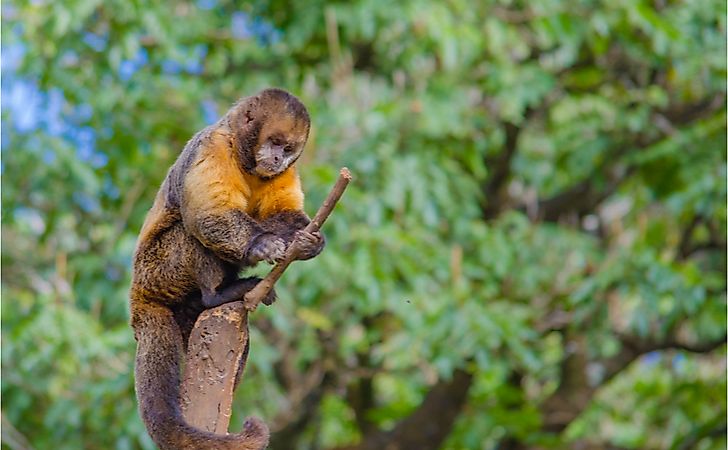
The golden-bellied capuchin is scientifically known as Sapajus xanthosternos. The species is found in Brazil in the Atlantic forest of southeastern Bahia. They inhabit submontane moist and tropical lowland forests as well as dry, semi-deciduous forests. They feed on fruits, flowers, seeds, leaves, nectar, insects, small reptiles, frogs, and eggs.
Threats Facing New World Monkeys
The biggest threat facing New World monkeys is the loss of their habitat. Over the years, deforestation has devastated the forests of South America, thus restricting some of the species to relatively small patches of forest. New studies have also revealed that New World Monkeys are particularly vulnerable to temperature increase as a result of climate change. Scientists believe that by the year 2050, about 86% of Neotropical primate ranges will experience temperatures increase of up to 37.4 degrees Fahrenheit. They also think that a temperature increase of over 39.2 degrees will affect about 41% of primate ranges and will likely push some species to extinction.











